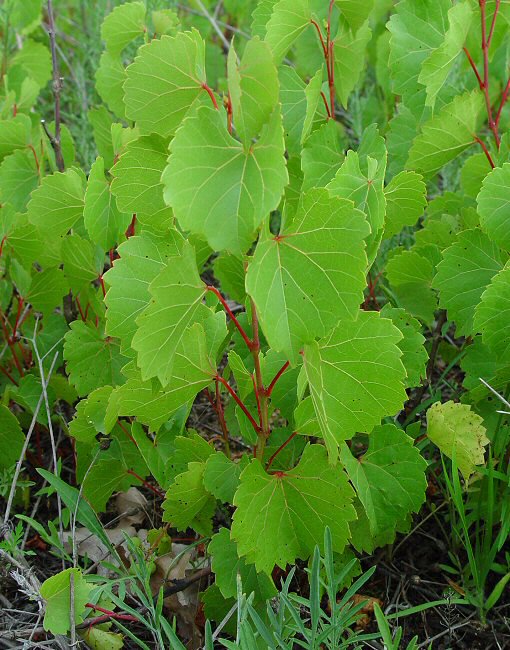Vitis rupestris Scheele
Sand Grape

Native
CC = 7
CW = 3
MOC = 39
© SRTurner
Vitis rupestris ScheeleSand Grape | |
 |
Native CC = 7 CW = 3 MOC = 39 |
© SRTurner |
|
Family - Vitaceae Habit - Vines, with tendrils restricted to uppermost nodes and positioned opposite leaves, lacking thorns or spines, sometimes incompletely or nearly completely monoecious or dioecious. Stems - Young stems circular in cross-section or somewhat angled, glabrous or sparsely and minutely hairy at flowering time, green, gray, or brown. Pith interrupted at the nodes, the diaphragms 0.3-0.5 mm wide on new growth, eventually thickening to 0.5-1.0 mm wide on older branches. Older stems with the bark shredding, not appearing warty. Tendrils absent or restricted to the uppermost nodes of the main stem and branches, present at no more than 2 adjacent nodes (every third node lacking both a tendril and an inflorescence), 2- or 3-branched.
Leaves - Alternate, simple, petiolate. Petioles 1/2-2/3 as long as the blades, sparsely hairy or glabrous at flowering time. Leaf blades mostly 3-10 cm long, mostly wider than long, kidney-shaped to depressed-ovate in outline, often somewhat folded longitudinally at maturity, unlobed or shallowly 3-lobed, the sinuses mostly broadly U-shaped, the lobes rounded or abruptly tapered or narrowed to a sharp but broadly pointed tip, the upper surface glabrous (occasionally sparsely and minutely hairy when young), often somewhat shiny. Undersurface of young leaves glabrous or sparsely pubescent with minute, straight, more or or less spreading hairs along and/or in the axils of the main veins.
Inflorescences - Usually opposite the leaves, at no more than 2 adjacent nodes, 2-7 cm long, broadly pyramidal to nearly globose.
Flowers - Petals mostly 5, fused at the tip, 1-3 mm long, shed as a caplike unit as the flower opens, greenish yellow. Stamens mostly 5. Nectar disc inconspicuous, short, deeply 5- lobed or divided into 5 separate glands alternating with the stamens. Style often very short, usually not persistent at fruiting.
Fruits - Globose berries, mostly less than 15 per infructescence, 6-12 mm in diameter, the surface with lenticels absent, black, sometimes glaucous. Seeds 5-6 mm long, light brown.
Flowering - May - July. Habitat - Streambanks, gravel bars. Origin - Native to the U.S. Other info. - This small grape can be found in the Ozark region of Missouri. Beyond Missouri it is found in a band ranging from Texas to southern Pennsylvania, though it is considered uncommon nearly everywhere except for Missouri and Arkansas. The plant is probably the easiest of the Missouri grapes to ID due to its creeping habit and broad leaves. The nearly glabrous underside of the leaves contrasts strongly with the common summer and winter grapes (V. aestivalis and V. cinerea, both of which have densely pubescent leaf undersides). The plant is usually about 1 m tall or less but it can get taller. It can form large populations on undisturbed gravel bars along Ozark rivers and streams. Photographs taken on Logan Creek, Reynolds County, MO., 6-10-04 (DETenaglia), also along Little Courtois Creek near Pea Ridge, Washington County, MO, 7-18-2025 (SRTurner). |